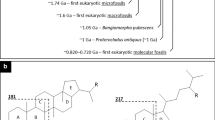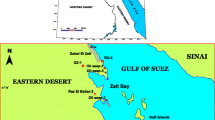Abstract
Diamictites from Late Neoproterozoic Nantuo tillites (∼600 Ma), and dolomites from the overlying Dousantuo and Dengying formations in the Yangtze region, southern China, were analyzed for solvent extractable hydrocarbons. Even though all these samples have low contents of TOC and have undergone overmature thermal evolution, there has been still preserved quite a large amount of hydrocarbons. Analysis of the extracts by gas chromatography-mass spectrometry (GC-MS) revealed the presence of n-alkanes, regular acyclic isoprenoids, tricyclic terpanes, hopanes, gammacerane, steranes, and polyaromatic hydrocarbons. Strict experimental measurements were performed in the analytical procedure to prevent any potential contaminants from being introduced. All these bitumens have molecular markers of Precambrian characteristics and no external organics derived from current contamination events or migrated hydrocarbons from younger strata. The maturity parameters for bitumens indicate that the hydrocarbons are of over-maturity, which is consistent with the thermal maturity of the host rocks. Consequently, it is concluded that the Late Neoproterozoic bitumens in the Yangtze region, South China, are indigenous to their host rocks, which provides the basis for our organic geochemical research on “Snowball Earth” and “Cambrian Explosion.”
Similar content being viewed by others
References
Boreham C.J., Crick I.H., and Powell T.G. (1988) Alternative calibration of the Methylphenanthrene index against vitrinite reflectance: Application to maturity measurements on soils and sediments [J]. Organic Geochemistry. 12, 289–294.
Brocks J.J., Buick R., Logan G.A., and Summons R.E. (2003) Composition and syngeneity of molecular fossils from the 2.78 to 2.45 billion-year-old mount Bruce supergroup, Pilbara Craton, Western Australia [J]. Geochimica et Cosmochimica Acta. 67, 4289–4319.
Buchardt B. and Lewan M.D. (1990) Reflectance of vitrinite-like maceral as a thermal maturity index for Cambrian-Ordovician Alum Shale, South Scandinavia [J]. AAPG Bulletin. 74, 394–406.
Chen Junyuan, Zhou Guiqin, Zhu Maoyan, and Ye Guiyu (1996) Chenjiang Biotas—The Testimony of the Cambrian Explosion [M]. pp. 222. Taiwan Nature and Science Museum Press, Taizhong (in Chinese).
Goodarzi F., Brooks P.W., and Embry A.F. (1989) Regional maturity as determined by organic petrography and geochemistry of the Schei Point Croup (Triassic) in the western Sverdrup Basin, Canadian Arctic Archipelago [J] Marine Petroleum Geology. 6, 290–302.
Gould S.J. (1993) How to analyze Burgess Shale disparity—A reply to Ridley [J]. Paleobiology. 19, 522–523.
Hoffman P.F., Kaufman A.J., Halverson G.P., and Schrag D.P. (1998) A Neoproterozoic snowball Earth [J]. Science. 281, 1342–1346.
Hoffman P.F. and Schrag D.P. (2002) The snowball Earth hypothesis: Testing the limits of global change [J]. Terra Nova. 14, 129–155.
Kvenvolden K.A. and Curiale J.A. (1998) Organic geochemistry—Linking the biosphere and geosphere: Introduction [J]. Organic Geochemistry. 27, 5–6.
Li Chao, Peng Ping’an, Sheng Guoying, Fu Jiamo, and Yan Yuzhong (2003) A molecular and isotopic geochemical study of Meso-to Neoproterozoic (1.73–0.85 Ga) sediments from the Jixian section, Yanshan Basin, North China [J]. Precambrian Research. 125, 337–356.
Peng Ping’an, Sheng Guoying, Fu Jiaomo, and Yan Yuzhong (1998) Biological markers in 1.7 billion years old rock from the Tuanshanzi Formation, Jixian strata section, North China [J]. Organic Geochemistry. 29, 1321–1329.
Peters K.E., Moldowan J.M., and Sundararaman P. (1990) Effects of hydrous prolysis on biomarker thermal maturity parameters: Monterey phosphatic and siliceous members [J]. Organic Geochemistry. 15, 249–265.
Peters K.E. and Moldowan J.M. (1993) The Biomarker Guide: Interpreting Molecular Fossils in Petroleum and Ancient Sediments [M]. Prentice Hall, Inc, Englewood Cliffs, New Jersey.
Radke M., Willsch H., and Leythaeuser D. (1982a) Aromatic components of coal: Relation of distribution pattern to rank [J]. Geochemica et Cosmochimica Acta. 46, 1831–1948.
Radke M., Welte D.H., and Willsch H. (1982b) Geochemical study on a well in the Western Canada Basin: Relation of the aromatic distribution pattern to maturity of organic matter [J]. Geochemica et Cosmochimica Acta. 46, 1–10.
Radke M. and Welte D.H. (1983) The methylphenanthrene index (MPI): A maturity parameter based on aromatic hydrocarbons. In Advances in Organic Geochemistry 1981 (eds. M. Bjoroy et al.) [M]. pp. 504–512. J. Wiley and Sons, New York.
Ridley M. (1993). Analysis of the Burgess shale [J]. Paleobiology. 19, 519–521.
Sieskind O., Joly G., and Albrecht P. (1981) Simulation of the geochemical transformation of sterols: Superacid effect of clay minerals [J]. Geochemica et Cosmochimica Acta. 43, 1675–1680.
Yan Ming, Liu Yingjun, and Ma Dongsheng (1995) Stratigraphic geochemistry of Upper-Middle Proterozoic suberathem in Northern Guangxi, China [J]. Chinese Journal of Geochemistry. 14, 231–242.
Wang Tieguan, Wang Chunjiang, Zhang Weibiao, Shi Quan, Zhu Lei, and Chen Junyuan (2003) Initial organic geochemical investigation on Late Neoproterozoic-Early Cambrian sediments in Yangtze region, China [J]. Progress in Natural Science. 13, 936–941.
Zhang Qirui, Chu Xuelei, Zhang Tonggang, and Feng Lianjun (2002) From global glaciation to “snowball earth”: Recent research on the Neoproterozoic glaciation event [J]. Geological Journal of China Universities. 8, 473–481 (in Chinese with English abstract).
Zhang Qirui and Piper J.D.A. (1997) Palaeomagnetic study of Neoproterozoic glacial rocks of the Yangtze Block: Palaeolatitude and configuration of South China in the Late Proterozoic Supercontinent [J]. Precambrian Research. 85, 173–199.
Zhong Ningning and Qin Yong (1995) Carbonate Petrology: Characteristics, Origin and Evolution of Macerals and Their Relationship with Oil and Gas [M]. pp. 196. Science Press, Beijing (in Chinese).
Author information
Authors and Affiliations
Corresponding author
Additional information
This work is financially supported by the National Natural Science Foundation of China (Grant No. 40172049).
Rights and permissions
About this article
Cite this article
Li, M., Wang, T., Wang, C. et al. Molecular composition and indigenity of organic matter in Late Neoproterozoic sedimentary rocks from the Yangtze region, South China. Chin. J. of Geochem. 25, 318–327 (2006). https://doi.org/10.1007/s11631-006-0318-2
Issue Date:
DOI: https://doi.org/10.1007/s11631-006-0318-2




